PBS’s hit show will be making a stop in Harrisburg on June 3. In 1998, I experienced the Antiques Roadshow phenomenon when it made a stop in Richmond, Virginia.
In April, 1998, a small notice appeared in the home section of the Richmond Times-Dispatch announcing that Antiques Roadshow would be making its last stop of the year in Richmond, Virginia, on August 29. “We’ve got to go,” my sister said, pointing to the announcement. “Count me in,” I replied.
Decisions, Decisions
The months flew by and before we knew it, August had arrived. The big question was, what would we take? Each ticket holder was permitted to bring two items into the “studio.”
The rule was that items had to be easily transported, as they had to move with their owners through the hours-long lines. Comfortable shoes and clothing also proved to be musts. While the lines move at a snail’s pace, they nevertheless move, allowing you no time to sit down.
Right up until Friday, the day I would leave for Richmond, we were going back and forth over what I’d bring. My mother really wanted a doll that had been dressed by the nuns at St. Joseph Hospital (it probably dates to 1910 or thereabouts) to be among the chosen items. She also suggested that we take along a decorative bowl that had belonged to her mother. A painted chair was also added to the mix.
Meanwhile, down in Richmond, Ginny was kicking herself for not having submitted photographs of a desk she had purchased at an auction 10 years earlier. Antiques buffs and woodworkers had all commented on its unusual style and asked for first dibs, should she ever want to sell it.
The large pieces of furniture you see on television aren’t hauled in the day of the show. Photographs must be submitted months prior to the production staff’s arrival. Pieces are selected from the photos and are transported to the site for inclusion in the taping of the show.
However, aficionados of the show told Ginny she could get around the rule by taking photographs or by bringing an item such as a drawer to count as one of her two items. She opted to give it a try with pictures. She also chose to take a vase that had belonged to our great-grandmother.
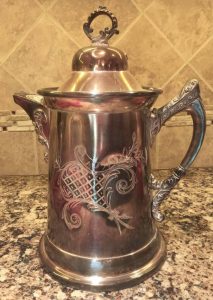 We decided that my brother-in-law John would be in charge of the doll, plus we “allowed” him to select an item of his own choosing to take along. He opted for a silver tankard, saying it would make his mother happy to get it appraised. We took inventory of our treasures and speculated that John’s tankard, which dates to 1850, would be the most valuable item among those we were taking.
We decided that my brother-in-law John would be in charge of the doll, plus we “allowed” him to select an item of his own choosing to take along. He opted for a silver tankard, saying it would make his mother happy to get it appraised. We took inventory of our treasures and speculated that John’s tankard, which dates to 1850, would be the most valuable item among those we were taking.
The Line Forms…
We excitedly set off for the Richmond Centre a little after 7 a.m. on that Saturday morning. It soon became apparent that a lot of people had the same idea. Traffic was heavy at that early hour and when we turned the final corner, we discovered a line that stretched for blocks.
Only 7,000 tickets would be distributed. We shrieked for John to stop the car and let us out. We assured him we’d hold a place in line for him — provided he could find a parking space and locate us before we entered the building. After that, he and his silver tankard (and the doll) were on their own! Luckily, he found us just as we were about to hand over our admission tickets.
The buzz on the street was that fans of the show had started lining up as early as midnight. Apparently, this is par for the course as far as the Antiques Roadshow goes. During the summer of 1997, it was estimated that more than 40,000 people passed through the traveling studio’s five locations. Such was not always the case; in fact, the show’s production station, WGBH in Boston, feared that the show wouldn’t get off the ground, as only 800 people showed up during the show’s first outing to Concord, Massachusetts, in 1996.
What draws thousands of people to the shows? A combination of game-show suspense, the chance to be a part of a television production, the possibility of hitting the jackpot and the opportunity to learn something from the pros attracts legions of antiques-bearing fans. Also, they don’t come just from the immediate area, but from far and wide.
A little after 8 a.m., we entered the building. We thought we had it made and talked about what we could do the rest of the day. Reality hit when we walked into the “holding room.” Picture the sports center at Franklin and Marshall College — only bigger. We were about 4,000th in line!
By 9 a.m., all but a few of the tickets had been distributed. We were told we’d reach the “set” about 1 p.m. At one point — about 10 a.m. — the fire alarms went off. Nobody moved. “No way am I losing my place in line,” a man behind us said.
About 11 a.m., the sound of crashing glass prompted a concerted gasp among the audience and then dead silence. All eyes turned to a woman who had lost part of what looked like a Victorian era lamp. She stayed in line, wanting to find out what the lamp would have been worth.
Eyeing The Competition
What did we see? Due to the fact that Richmond was the capital of the Confederacy, Civil War weapons such as rifles and swords were numerous, but apparently most were run of the mill.
This contrasted with the man who appeared on one of the shows a year earlier with a sword that had been regularly used at family picnics to cut open watermelons. (At that revelation, the appraiser became quite distressed.) Its owner explained he was contemplating selling it at a garage sale his wife was planning and wanted a ballpark figure on its worth.
It turned out that this particular sword had been made for a big-wig and was quite valuable — in the vicinity of $30,000! (At this point, the owner appeared to go into shock.)
We also saw quite a few paintings — everything from ancestral portraits and hunt scenes to works by Picasso wannabees. Again, nothing of note emerged.
Small-scale furnishings — chairs and such — were also big items. A convex mirror that had been imported from England at the turn of the 19th century was interesting. However, the appraiser pointed out that it had undoubtedly been embellished by American artisans, as it was decorated with leaves and an eagle, all crafted from American pine. Nevertheless, appraiser Wayne Pratt placed its value at between $25,000 and $30,000!
Another find was a hand-embossed leather key basket (circa 1850) that was appraised by Carolyn Remmey at $20,000 to $30,000!
One couple from Williamsburg received good and bad news: Their slant-drawered highboy (circa 1760), for which they paid $500, was now worth $15,000. However, if they hadn’t refinished it, the value would be somewhere in the vicinity of $100,000!
Jewelry was another hot commodity. Here, the find of the show consisted of what the owner considered to be costume jewelry. She explained that the pieces belonged to a great-aunt whose husband, a member of Congress, loved to shower her with gifts.
Among the treasures was a two-tiered diamond necklace, a ring that sparkled with a 3-carat diamond and 2.5-carat Burmese ruby, and a bracelet that contained 70 baguette diamonds, 31 rubies and 144 round diamonds — 15 carats in all.
The owner explained that the items were rarely worn, as her mother, who had first inherited the pieces, was often ridiculed by her friends for wearing such “tacky” jewelry. The verdict, as supplied by appraiser Berj Zavian, totaled $275,000!
However, the star of the Richmond show turned out to be a rooster. “Look at that,” was an oft-heard comment as the piece made its way through the line.
Indeed, it was gorgeous. Hand-carved in the early years of the 20th century (by a carousel carver, no doubt, said appraiser Ron Bourgeault), its golden sheen had been perfectly aged by a combination of dust and dirt buildup and children sitting astride it.
The owner, a woman from Washington, D.C., who was tapped to tell her story on camera, explained that the rooster had belonged to a great-uncle who sold dairy and poultry products in his general store. How the great-uncle acquired it, the owner was not certain.
Bourgeault then took over, explaining that like the famous cigar store Indians, roosters such as this one were used to advertise the fact that a general store sold poultry and dairy products.
Other than a problem with one of its feet, the rooster was found to be in pristine condition (original paint included) and was appraised at $5,000 to $7,000!
The news traveled like wildfire. Gasps echoed through the hall and rejuvenated many a weary soul whose arms were growing weak from clutching their own treasures.
Five Hours Later!
By 1 p.m., we had reached our hour of reckoning. We were on the set that is widely seen on television. Once you reach this area, your treasures are categorized and you’re given tickets that will gain you admission to the appropriate areas — glass, furniture, jewelry, etc. This is where your heart starts beating a little faster. The lights are bright, cameras are whirling, expectations are high and right in the middle of the fray stood the show’s host, Chris Jussel.
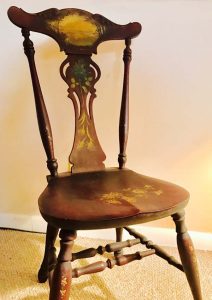 I made a beeline for the furniture area. Ahead of me was a couple from western North Carolina who had brought along a very unusual blanket chest. I asked about its origins, and the man explained that it dates to the late 1700s or early 1800s and was crafted by settlers from South Central Pennsylvania. “Oh my gosh, that’s where I’m from,” I told him.
I made a beeline for the furniture area. Ahead of me was a couple from western North Carolina who had brought along a very unusual blanket chest. I asked about its origins, and the man explained that it dates to the late 1700s or early 1800s and was crafted by settlers from South Central Pennsylvania. “Oh my gosh, that’s where I’m from,” I told him.
The appraiser was obviously overwhelmed by the find and ran off to invite his fellow appraisers to inspect the chest. They, too, grew very excited, and soon the man and his chest were off to the filming area that is referred to as the “green room.” Those who make it that far are kept in the dark about the value of their items, which explains the reactions of some of the people who appear on the television shows.
It was my turn. The format of the appraisal process might best be explained as the Psychic Friends Network in reverse. Instead of predicting the future, the appraisers can elaborate on an item’s origin and past life.
For instance, I was informed that my mother’s chair represents a transition from the Victorian era to the Arts and Crafts movement. It also represented the rise of the furniture manufacturing industry. “It was probably made in the Northeast at the turn of the [20th] century,” the appraiser explained. Indeed, the bottom of the chair was stamped with the seal of a company in New York.
The appraiser found the chair’s design to be somewhat unusual in that several styles — Classical, Victorian and a touch of Arts and Crafts — were utilized.
He also pointed out that the hand-painted decorations were in great condition and cautioned me to leave them as is. I was also warned not to have the chair refinished because ruining its original patina would ultimately impact its value.
While he found the chair to be interesting, the appraiser explained that it had not reached the magic age of 100 years old. The verdict? $125. I was disappointed.
 Next, I went to the pottery area where I presented the bowl that had belonged to my grandmother. The bowl’s filigreed outer rim is gilded with gold while the bottom displays a decorative motif of a finch sitting among hydrangeas.
Next, I went to the pottery area where I presented the bowl that had belonged to my grandmother. The bowl’s filigreed outer rim is gilded with gold while the bottom displays a decorative motif of a finch sitting among hydrangeas.
“I bet this was a wedding gift,” the appraiser announced. “These were popular wedding gifts in their day.” (He was correct.) “It was made in Germany at the turn of the century.” (That was news, as no markings conveyed its origins.) “The decoration is not hand painted, it was a transfer method that the Germans used.” (Could have fooled me.)
He then asked if I knew anything else about the piece. I explained that my grandmother, in need of money, once offered it to the rag lady who frequented Cabbage Hill. “She offered her 50 cents,” I explained, “but apparently my grandmother felt that wasn’t enough and held onto it.” The appraiser commented that therein explains the beauty of family pieces — a price cannot be placed on something that has sentimental value attached to it.
Again, because it had not reached the magic age — 100 — he could only appraise it at $125. “But,” he countered, “it will increase in value. It’s very Victorian, and Victorian is on the verge of making a comeback. People are becoming very interested in restoring Victorian houses because all the Colonials have been done. Victorian is the next wave.”
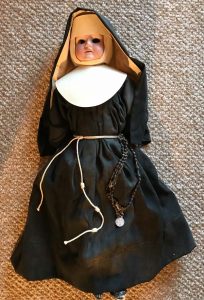 Meanwhile, John was in the doll area. My mother had somehow “inherited” the nun doll from one of her aunts. She figured it was about 80 years old. The nuns at St. Joseph Hospital had dressed her in a habit — complete with a miniature strand of rosary beads — identical to the ones they wore.
Meanwhile, John was in the doll area. My mother had somehow “inherited” the nun doll from one of her aunts. She figured it was about 80 years old. The nuns at St. Joseph Hospital had dressed her in a habit — complete with a miniature strand of rosary beads — identical to the ones they wore.
Until August 28, 1998, the poor doll had been in a dresser drawer — face up — for 40 years. The position had caused her eyes to fall into her head.
The appraiser shook his head and lamented the fact that treasures such as this are often hidden away. “What enjoyment can be derived from such items if they’re kept under wraps?” was his comment.
The appraiser went into his psychic mode and speculated that the doll had been dressed by nuns from a convent somewhere in the Northeast, perhaps for a fundraiser of some sort. (Indeed, the nuns who created these dolls donated the money from their sale to the hospital.)
The appraiser recommended that we have the eyes repaired, as the minor procedure will only enhance its value. We were also encouraged to hold onto the doll, as there’s a subculture of collectors who collect nothing but nun dolls. He also speculated that with more and more orders trading their habits for street clothes, the doll’s value will only escalate. Its value was placed at $400, a figure that amazed us.
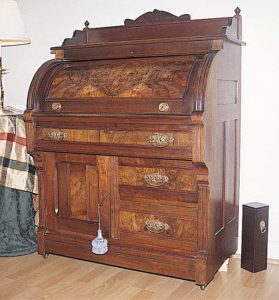 Ginny had reached the appraiser in the furniture line. He looked at the pictures of the cylinder desk she had bought at an auction in Lancaster that was being held for Gladys Good, who had owned the popular Good’s Dairy Barn with her husband, Bob, and was downsizing, as she was making plans to move to a retirement community.
Ginny had reached the appraiser in the furniture line. He looked at the pictures of the cylinder desk she had bought at an auction in Lancaster that was being held for Gladys Good, who had owned the popular Good’s Dairy Barn with her husband, Bob, and was downsizing, as she was making plans to move to a retirement community.
Ginny and I had worked for the Goods as teenagers and she really wanted something from this particular sale (again, sentiment was coming into play). John had always wanted a roll-top desk, so they attended the sale and bid on the unusual Victorian cylinder desk. It was theirs for $450.
The appraiser studied the photos and pronounced it a very good buy. The cylinder top, made of burled walnut, exhibited graining that was a mirror image of itself. In addition, the rail around the top was intact.
This appraiser also sang the praises of Victorian furniture, saying that pieces such as the desk would become even more valuable over the course of the next decade. The desk was appraised at $1,200.
We had two items to go, and both appraisals resulted in the surprises of the day.
 I caught up with Ginny just as she was handing over the vase. I had always assumed the pink vase is a fancy version of depression glass (it’s etched with oak leaves and acorns). “Oh, no,” the appraiser corrected me. “This is American cameo glass.” Then she stopped talking and kept looking at the vase and then at us. “It was probably made in the Ohio Valley about 100 years ago.” Silence. “I don’t know … ” she muttered, almost to herself.
I caught up with Ginny just as she was handing over the vase. I had always assumed the pink vase is a fancy version of depression glass (it’s etched with oak leaves and acorns). “Oh, no,” the appraiser corrected me. “This is American cameo glass.” Then she stopped talking and kept looking at the vase and then at us. “It was probably made in the Ohio Valley about 100 years ago.” Silence. “I don’t know … ” she muttered, almost to herself.
“Just tell us 20 bucks, and we’ll be outa here,” I thought to myself. Ginny apparently shared the same thought.
Someone approached the appraiser with a question, and she excused herself for a moment. “Now, where were we?” she asked when she returned. “It’s a nice piece … [American cameo] is really starting to come on the market … I’m glad you like it … I’d say maybe $1,000 at auction.”
It was good that the appraiser was holding the vase, because we would have surely dropped it. “I let friends borrow this for parties,” Ginny said, still in a state of shock.
Meanwhile, John was having the tankard appraised. He took the bad news like a man. His mother had spent $200 to have it resilvered. Not a wise thing to do, the appraiser said. Original condition — even less-than-desirable original condition — is always preferable. As a result, the tankard was valued at only $60. “My mother is going to be so upset,” John said, as we made our way out of the studio.
Antiques Roadshow airs Mondays at 8 p.m. Locally it can be seen on WITF.
The Harrisburg stop — along with those in Green Bay, Wisconsin; St. Louis, Missouri; New Orleans, Louisiana; and Portland, Oregon — will comprise Season 22 of Antiques Roadshow, PBS’s most-watched ongoing series. Three one-hour episodes, which will air in 2018, will showcase the Harrisburg stop.
The manner in which tickets are distributed has changed since those early years. Tickets are no longer distributed on the morning of the event. Now, interested parties must submit their names for a chance to win two tickets (per household). To enter your name and view complete application rules, visit pbs.org/antiques/tickets. You can also call 888-762-3749 for more information. The deadline for applications is April 10, 2017 (11:59 p.m. PT).
Ticket holders will be permitted to bring two items for appraisal purposes. Furniture submissions are also being accepted. Selected pieces will be transported to and from the event at no cost to the owner. For details, visit pbs.org/wgbh/roadshow/furniture/.
As this is the region’s first time to host the show, executive producer Marsha Bemko is excited to visit Harrisburg. “I can’t wait to explore the new area and see what local items we uncover,” she noted in a press release.



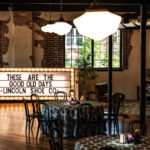

SHARE
PRINT